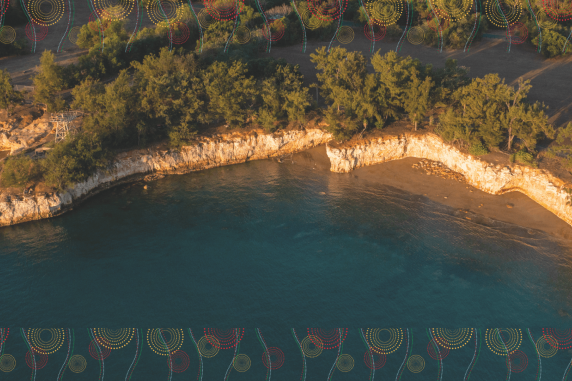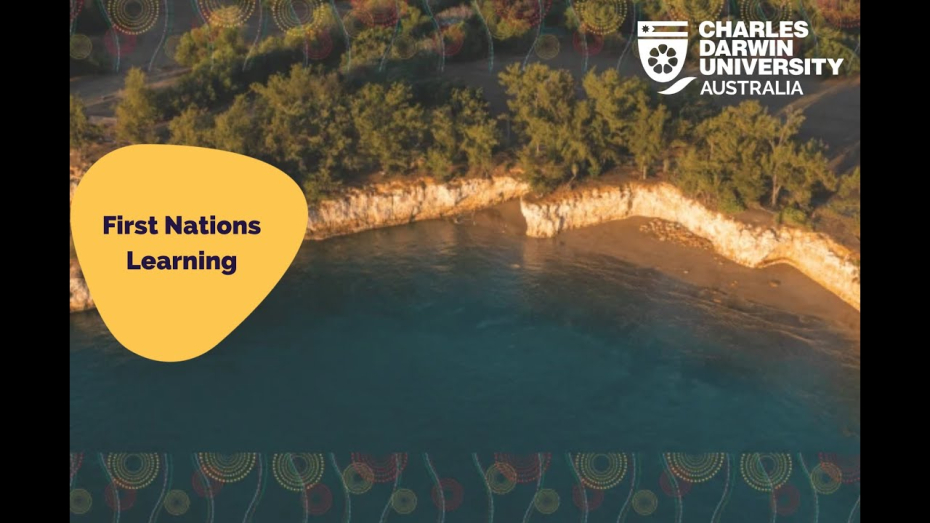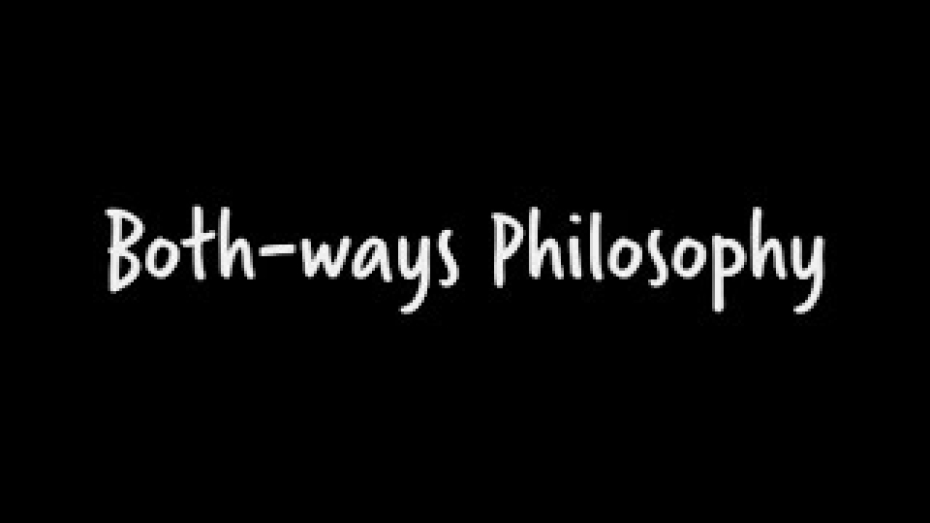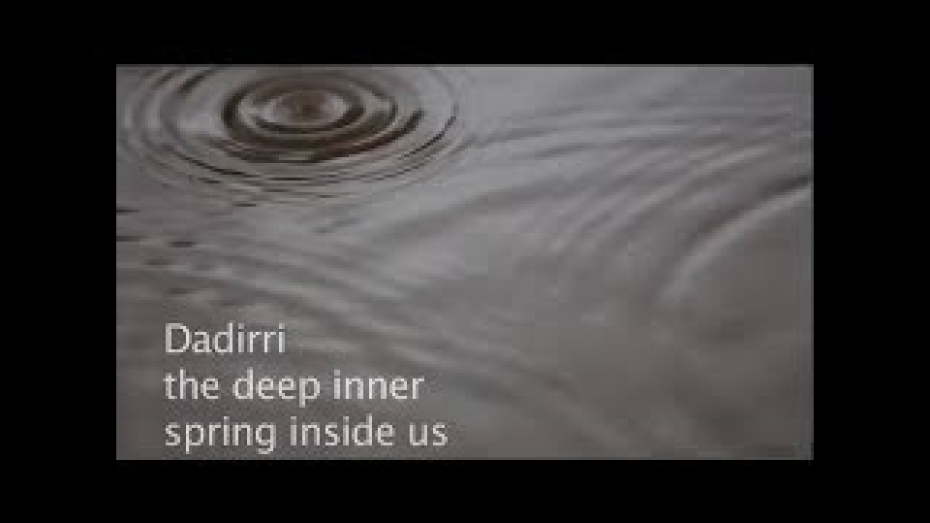Milpirri is a metaphor. The rising hot air and the falling cold air create the Milpirri clouds and describe the meeting of two very different cultures and ways of life. At the point of meeting, there is a clash. The thunder and lightning portray the pain and confusion that came about at the meeting of traditional Warlpiri and mainstream European cultures. However, the metaphor goes on to suggest that there is a way of merging the two, without violating either, to create refreshing and life-giving results.
Steve Jampijinpa Patrick
This page explores the deep educational traditions of Australia's First Nations peoples and how these are included in university classrooms.
At Charles Darwin University, learning is based on Constructivism. This means that knowledge is built together through experience and reflection.
This page will explain important ideas like Both-Ways Learning, 8 Ways Learning, Yarning and First Nations Learning at CDU.
These approaches improve the university experience by combining First Nations and Western ideas. They shape how classrooms work and how learning happens at the university.
Aims of the page:
- Understand the First Nations
- Perspectives on learning
- Understand why these perspectives are important
Introductory video
Before you continue, reflect on your understanding of First Nations learning. Watch this introductory video to understand why this understanding is important.
Constructivism at CDU
What is Constructivism? Learn more about this pedagogical approach in universities and what it means to students.
Constructivism: A Student’s View
At university, learning often happens with others. It's important to have chances to work with your classmates and lecturer, who guides your learning. Working with others helps you talk about ideas, plan tasks, and understand your coursework better. Sometimes, you will work in groups for assignments.
Your learning spaces are set up to support collaboration. For example, tables may be arranged for group work, and the usual divide between where the lecturer stands and where students sit can be less strict.
In online settings, collaboration happens through tools like discussion boards, breakout rooms, video calls (like Collaborate or Teams), or shared platforms like Office 365.
Your lecturer helps guide your learning. They will help you explore new ideas and show you how to work well with others. They know when to step in and when to let you explore on your own.
Both-Ways learning
Learn about Both-Ways learning and how it is a bridge between First Nations and Western knowledge.
What is Both-Ways learning?
Both-Ways Learning is an educational approach that combines First Nations knowledge with Western academic knowledge. It supports a respectful exchange of ideas from both sides, encouraging learning that strengthens First Nations identity and cultural awareness in the university community.
History
Both-Ways and Two-Ways often mean the same thing, though some experts point out differences. In 1990, Stephen Harris introduced "Two-Way schooling" to describe learning that draws on two areas of knowledge. Since then, the terms have been used to show how Western and First Nations knowledge systems can come together. A common metaphor is the Garma, where saltwater and freshwater meet in a lagoon.
This idea of teaching First Nations culture and language alongside Western subjects became more popular in the 1980s. First Nations educators like Mandawuy Yunupiŋu and Nalwarri Ngurruwutthun helped develop the Both-Ways approach.
Video: Both-Ways learning
Hear Robyn Ober speak about Both-Ways learning.
Key principles of Both-Ways learning
Respect for Knowledge Systems: Both-Ways Learning values First Nations and Western knowledge systems. First Nations knowledge, rooted in storytelling and community, is equally respected alongside Western science and academics.
A Shared Learning Journey: Learning is a group effort. In Both-Ways learning, students, staff, and the community learn together, sharing ideas and growing together.
Student-Centred Learning: This approach puts students’ cultures and experiences at the centre. First Nations students can use their knowledge to reach their academic and career goals, connecting their heritage with Western learning
Why does Both-Ways learning matter?
In today’s world, universities are places where diverse cultures meet. Both-Ways Learning strengthens First Nations identity and helps all students learn to respect and work with other cultures.
Both-Ways Learning builds confidence and a sense of belonging for First Nations students. It makes sure education supports their cultural identity rather than replacing it.
For all students, it is a chance to engage with First Nations knowledge, learn cultural competence, and expand their worldviews.
Both-Ways Learning reminds us that knowledge comes in many forms, and respecting all ways of knowing makes education more inclusive.
Applying your learning
Check your understanding of Both-Ways Learning by dragging and dropping the correct word choices:
8 Ways Learning
The 8 Ways of Learning framework, created by Dr Tyson Yunkaporta, uses First Nations knowledge systems. It offers teaching strategies that work well for First Nations learners and can help many students. This framework highlights the diversity of learning, using methods
connected to culture and community.
The 8 Ways of Learning are:
1. Story Sharing: Learning through stories helps people connect and explain complex ideas.
2. Learning Maps: Using diagrams or symbols to show understanding and see how different ideas fit together.
3. Non-verbal Learning: Learning through observation, imitation, and visual cues.
4. Symbols and Images: Using visual aids to explain ideas simply and clearly.
5. Land Links: Connecting knowledge to the land and environment is important to First Nations perspectives.
6. Non-linear Thinking: Learning in a circular way, revisiting ideas to deepen understanding.
7. Deconstruct/Reconstruct: Breaking down ideas to understand them better, then building a broader understanding.
8. Community Links: Engaging with the community as part of learning.
8 Ways Learning Infographic
Check out this infographic, which demonstrates the links between the 8 Ways:
Now watch this video from the Australian Indigenous College that explains these connections:
Applying your learning
Drag and drop the 8 Ways of Learning into the correct sentences in the text.
Yarning
Learn more about the concept of Yarning and how this is applied to learning at university.
Yarning and learning
Yarning is a First Nations learning and communication method involving storytelling and conversation in a relaxed, informal setting. Participants engage in deep listening, share firsthand experiences, and build understanding through talking. Yarning is not just about exchanging information; it is about creating relationships and trust.
At university, Yarning can create a culturally safe space for students to share their perspectives and learn from each other. This process encourages reflective thinking and fosters an inclusive environment, making it especially valuable in settings where diverse worldviews are present.
First Nations learning at CDU
Find out more about what the principles of First Nations learning look like in practice at CDU.
Expectations of academic staff
At CDU, academic staff are expected to prioritise students' needs and recognise First Nations knowledge in their teaching. They are expected to include First Nations content in their courses and continue professional development to improve cultural awareness.
Reflection and review of teaching practices are also important to keep improving their approach.
What students can expect in lectures and course materials
Embedding First Nations Content: Students can expect to see First Nations content and pedagogy integrated into teaching practices, with a curriculum that reflects the knowledge and perspectives of First Nations peoples.
Acknowledgment of Country: It is common for lecturers to include an Acknowledgment of Country in unit information guides and other materials to honour the land's traditional custodians.
Collaboration with First Nations People: Students may find that learning materials have been prepared or peer reviewed by First Nations individuals. This approach often includes real-world practice scenarios and storytelling that aim to represent First Nations communities without stereotypes.
Inclusion of First Nations Voices: Lecturers may include readings by First Nations authors and invite guest lecturers from First Nations communities to share their perspectives and experiences.
Culturally Safe Practices: Course content is designed to be culturally safe, with teaching methods that recognise and respect the cultural identities of all students.
Feedback and Adaptation: Lecturers may be open to receiving feedback from students and willing to adapt their teaching practices better to meet the needs and expectations of First Nations students.
Co-Teaching Opportunities: In some cases, students might experience co-teaching by a First Nations educator, providing diverse perspectives and enriching the learning experience.
Applying your learning
Do you understand some of the differences between Constructivism and First Nations Learning?
Try this activity to check your understanding:
Reflect on your learning
Watch this short video about the concept of Dadirri (Deep Inner Listening). As you listen:
- Reflect on what you have learned in this material and your new understanding of First Nations learning and reflective practice.
- Consider how to apply this knowledge in your studies and future career.
Useful resources
More information and further reading.
CDU Webpages and resources
For more information about First Nations learning at CDU, visit the First Nations Leadership page and Lecturer Guidebook. For a First Nations Student Perspective refer to the Student Guidebook
Both-Ways learning
8 Ways Learning
Explore the 8 Ways Pedagogy Framework to understand First Nations teaching practices in Australian education.
Performance as a bridge
Yarning as a protected space
Acknowledgements
We want to acknowledge the invaluable contributions of Trudy Avlonitis, Kungarakan, Manager of First Nations Student Services; Dr Cat Cutay, Senior Lecturer in Information Technology; Matthew Grant, Library Services Officer; Dr Kate Golebiowska, Senior Research Fellow, Northern Institute; Robyn Ober, Indigenous Researcher, Bachelor Institute; Darcy Sorensen, Academic and Research Librarian, and Dr Tracy Woodroffe, Senior Lecturer, Indigenous Knowledges without whose knowledge and collaboration, this page could not have been produced.






